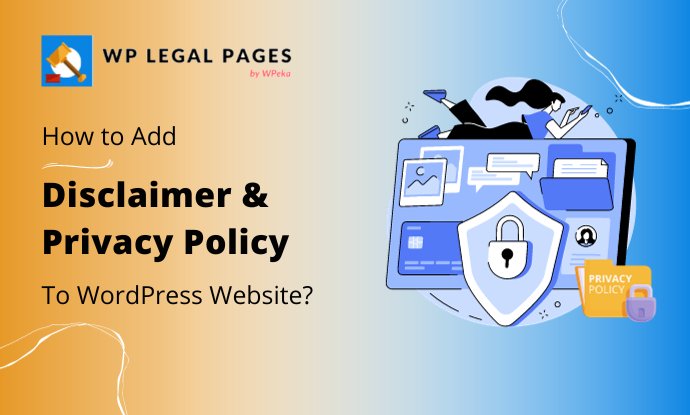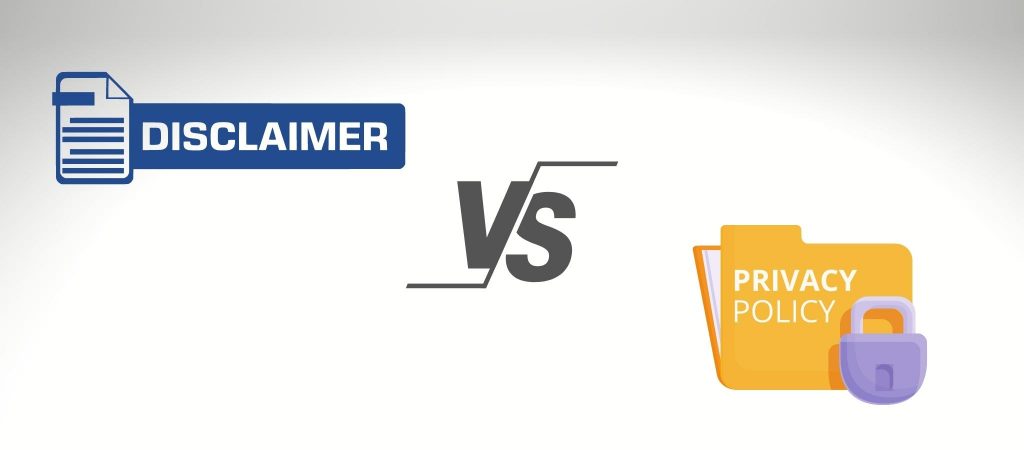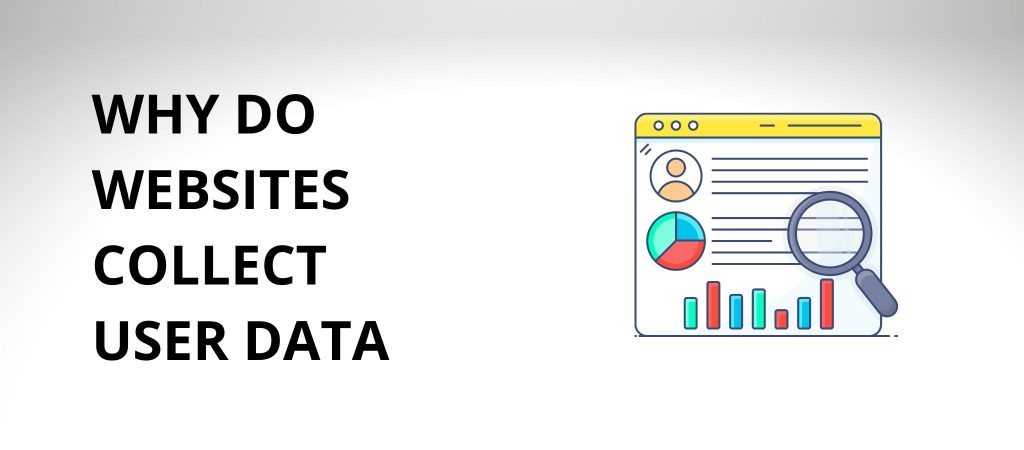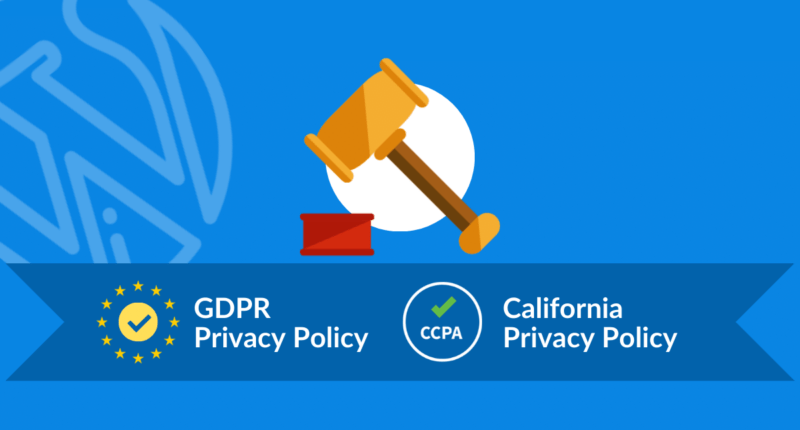Difference Between Disclaimer And Privacy Policy & How To Create Them?

Have you ever wondered about those small print things at the bottom of websites?
Well, they’re not just there for show! In the online world, where information flies around all the time, understanding the difference between disclaimers and privacy policies is pretty important for both the folks running the websites and the people using them. These legal documents are like the rulebooks that keep things fair and safe.
So, let’s learn about what makes disclaimers and privacy policies different and how you can make your own.
What Is A Disclaimer and Privacy Policy?
A website disclaimer is generally an official statement that can protect you, the website owner, from various troublesome situations. This page can be used to legally specify or limit the scope of a particular firm’s or website’s legal bindings.
Privacy policy discloses how a firm or a company gathers, manages, uses, and shares the customers’ data. Thus, it becomes a legal fulfillment for the security of the data your website collects.
Both disclaimer and privacy policy are an important part of any website as per industry regulation qualification. This article talks about what a disclaimer/privacy policy is, why it is important, template examples, and the difference between a disclaimer and a privacy policy.
Disclaimer VS Privacy Policy

It’s crucial to understand that disclaimer and privacy policy are two different recommended fine print on your website. One can usually find disclaimer and privacy policy pages on most of the websites these days. Several sites have both of these legal pages, some have just one of them, and then there are site owners who merge these two pages into one.
All in all, it is recommended to have them as two different pages as both of these pages aim at helping you and your website avoid liability. Here are the key differences between these two pages on any website.
Differences between Privacy Policy and Disclaimer
| Feature | Privacy Policy | Disclaimer |
| Purpose | Informs users about how their personal data is collected, used, and shared. | Protects the website owner from legal liability. |
| Scope | Covers all aspects of personal data handling, like collection, storage, use, disclosure, and transfer. | Covers specific areas of potential liability, like copyrighted materials or the accuracy of information provided on the website. |
| Format | A lengthy document with detailed explanations of data practices. | Shorter statement or a series of statements. |
| Legality | Required by law for websites that collect personal data. | Not legally required, but recommended for risk management. |
| User Consent | Require explicit consent from users to collect personal data. | Does not require user consent. |
| Enforcement | Enforced by data protection authorities. | Self-enforcing. |
Including privacy, the page is unavoidable if your website is collecting user data, and you are bound by the law to have this page on your site. However, the disclaimer is a page that doesn’t come with any such condition by law, regardless you’re dealing with user data or not.
Website owners often include both of these web pages to remain on the safe side. Including these two pages will save you from several legal disputes that might arise during your site’s operation.
How to Create a Disclaimer and Privacy Policy?
If you own a website that offers a blog on ‘how to’ or even provides instructional blogs. You need to add a disclaimer page in the same.
These days, every site collects user data, and yours may too. It’s good practice to add a privacy policy that will keep you safe and protected from legal liabilities or bindings.
You can add these pages to your website’s footer, making them readily available for your viewers. Because if you are using content management systems on your site. The disclaimer and privacy policy pages may not show up.
You might want to get rid of it before starting the process of adding these legal pages to your website.
Moreover, you can create a disclaimer and privacy policy easily by using our policy generator plugin. You can use them and get the most out of these legal pages.
One such plugin is WPLegalPages which comes with 25+ legal Templates and is super easy to use.
Legal Compliance with WP Legal Pages
WP Legal Pages is a popular legal page generator that helps you create professional policy pages tailored to your requirements across multiple geographies.
When a website has clearly defined legal policies, users feel reassured and are likely to engage with the site without fear of unexpected legal consequences.
Using WP Legal Pages, you can create pages for professional privacy policies, terms of use, terms & conditions, eCommerce returns & refund policies, affiliate disclaimers & more.
Features and Benefits of WP Legal Pages
WP Legal Pages has multiple expert-vetted legal pages and over 3,70,000+ downloads. Additionally, bloggers, affiliate marketers, corporate websites, e-commerce stores, and consultants use WP Legal Pages for its ease of functionality and legal compliance.
This helps create and maintain legally compliant documents on your website by offering a range of features that help protect your website interests and improve transparency with your audience. Thus creating a trustworthy environment for your users!
Let’s explore more features:
- Library of Legal Templates: WP Legal Pages offers a wide selection of pre-designed legal templates, including privacy policies, terms and conditions, disclaimer statements, and more.
- Announcement Banner: Display announcement banners on your website whenever any legal pages have been updated.
- Responsive Pop-Ups: WP Legal Pages offers an option to create functional and responsive popups. These pop-ups can showcase forced agreements or privacy policies to the users.
- Cookie Bar: You can add a cookie bar on your website to inform visitors about the cookies you use and the information you collect.
- Guided Wizard: This interface guides users to create whole legal pages by asking a few questions and guides you to add necessary sections to your policy pages, making the process seamless.
Furthermore, with WP Legal Pages, you can create multiple customized legal pages to ensure total website security.
Get tailored pages like privacy policy, cookie consent, copyright policy, and more on a single platform.
How to Install WP Legal Pages Plugin?
Head over to your WordPress Dashboard
Click on Plugins > Add New
Search for WPLegalPages on the search bar
Click on the Install Now button, and then activate
The WP Legal Pages plugin is now activated and ready to use.
Once it has been installed & activated properly, you can then find it on the left side of your WordPress dashboard. And then, you can use the templates available in the plugin. All you’d have to do is twist and tweak it according to your business and publish it on your website.
How To Add Disclaimer Using WP Legal Pages?
The purpose of a disclaimer is to save a website owner from legal issues. There are many different types of disclaimer templates, as problems are different for every single niche. Here is a list of some common disclaimer examples –
- Affiliate Disclaimer: If you participate in an affiliate program, you are legally required to disclose your relationship with the brands you promote. This disclaimer informs your visitors that you will earn a commission for any sales made through your affiliate links.
- Copyright Disclaimer: To protect your copyright, include a notice with your business name, production year, the copyright symbol, and an “All rights reserved” statement.
- Confidentiality Disclaimer: Confidentiality disclaimers ensure that only certain users will view certain content. These types of disclaimers are usually used for emails and provide a sense of security and protection.
- Warranty Disclaimer: A warranty disclaimer saves a website owner from unnecessary claims. It simply states that the website will not be responsible for any damages caused by its products or services.
- Investment Disclaimer: If you give financial advice on your site, the investment disclaimer is for you. You must state that you will not be responsible for the result of the advice.
Which Type of Disclaimer should I Use?
What is a disclaimer? Which kinds of disclaimers you should use completely depends on the type of your website. For instance, if you run a medical website and give medical advice, you must publish a disclaimer stating that none of your prescribed remedies should be used without consulting a doctor.
Similarly, if you run a beauty blog, you should publish a disclaimer declaring you will not be responsible if anything unfavorable happens using your products or tips. Visitors should use them at their own risk. Some common kinds of disclaimers that almost all the sites carry are – copyright disclaimers, views expressed disclaimers, and use at your own risk or no responsibility disclaimers.
Check out the step-by-step process to add a disclaimer to your website using WP Legal Pages.
In your WordPress dashboard, Go to WPLegalPages> Create Legal Page.

Scroll down and click CREATE General Disclaimer.

Select your language and domain, and click NEXT.

Review the general disclaimer created by WPLegalPages and click CREATE AND EDIT.

Make the necessary changes and click Publish.

Your General Disclaimer is now posted on your website.

Why is the Disclaimer Page Important?
Now that you know what a disclaimer is, you should also know why it is important. It can be seen as a shorter version of a business or website’s terms and conditions. The following points depict the importance of this page in detail:
- A disclaimer page, no matter how brief or short, can protect you from legal action.
- It is a page that states that the content on your website is informational, but viewers must use their own discretion when using it as a part of a contract.
- A disclaimer page absolves you of responsibility if a visitor uses your content and it harms them.
- You can also include fine print stating that the website advertisements and reviews are entirely promotional and that you don’t endorse them by any means.
The disclaimer clarifies to the users of your website’s service or commodity that you won’t be holding the guarantee for inaccuracies of any content, product, or service.
How to Create A Privacy Policy Using WP Legal Pages?
It isn’t quite tough to understand that user data is collected by nearly every other website these days.

The site owners tend to gather this data for several reasons, some of which are as follows:
- Maintain a database of user data.
- To get a subscription.
- Modify the website according to the geographical location and preferences of the users.
- To collect statistical data, which includes the number of advertisements viewed and the number of total views on your website.
Furthermore, check out the step-by-step process to add a Privacy Policy for your website using WP Legal Pages.
In your WordPress dashboard, Go to WPLegalPages> Create Legal Page.

Click on CREATE Standard Privacy Policy.

Make the necessary changes and click on NEXT.

Fill in the details of the type of data collected and shared. Then click on NEXT.

Review the privacy policy and click CREATE AND EDIT.

Edit any changes in the privacy policy and click Publish.

Your privacy policy is now published on your website!

Importance of Privacy Policy?
Your viewers have all the right to know about how your company uses their information. Hence, to assure them that their data is safe, you should add a privacy policy page on your WordPress site.
- You can also state how data is collected. Your privacy policy page answers questions such as, “Is the data collection method automated?” or “Is a form to be filled out?”
- This page lets you convey to your clients about their data storage.
- It is one way a website conveys to its clients that the information they share is safe and will be used only to their benefit.
Lastly, you can include your contact details on the privacy policy page to be as transparent with your clients as possible.
Key Takeaways
It becomes clear that website owners have to deal with many parameters to run the business effectively. This is why it seems logical to adopt methods to protect your website from any future legal action.
By now, you should have a clear idea about the importance of disclaimer and privacy policy pages and how they will benefit your site.
This guide will certainly come in handy when you want to add any or both of these pages to your own website.
If you liked reading this post, Check other informative articles:
- Website Legal Requirements and Tips to Meet Them
- Simplified Guide To Set Up Cookie Banners For eCommerce
- How To Add Copyright Text To A Website
Get WP Legal Pages to achieve complete compliance for your website!


Leave a Reply
You must be logged in to post a comment.